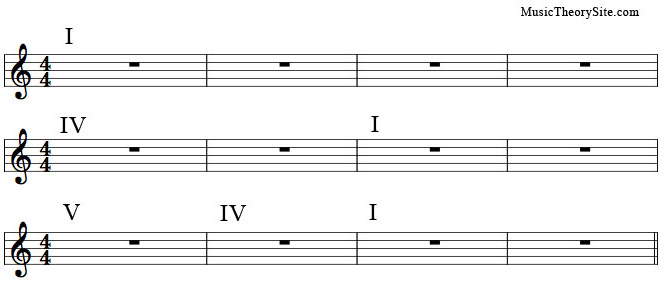12 Bar Blues Explained, Common Chords and Improvising
12 bar blues is one of the most popular chord progressions and is most notably used in blues songs but, since most popular music today came from the blues, is also widely used in other genres of music. The more you get used to the 12 bar blues progression you’ll also find that many other rock and pop progressions have their foundation built on it even though they differ slightly.
The Progression
Here is the 12 bar blues progression.

It starts on the I (or tonic) for four measures then moves up to the IV for 2 measures. This move to the IV (or subdominant) offers some interest to the listener. The progression then moves back down to the I for two measures providing some relief from the previous assent. As soon as you’re feeling back at home the V (or dominant) chord takes over for 2 bars and descends down to the IV chord for another two bars which finally returns to the I chord
Commonly Used Extended Chords
While you could play the blues progression with simple major triads like the above example it’s generally played with all dominant 7th chords. While this isn’t exactly diatonic to the key (the I7 & IV7 are not diatonic chords in a major key) it makes for a more bluesy sound and is provides the notes and support needed for improvising with the blues scale. Without these 7th chords a blues scale would sound a little out of place because it contains those 7ths.
For a more complex sound a lot of people opt for 9 chords instead of the dominant 7ths. 9 chords contain the dominant 7 scale degree but also add the 9th degree.
Improvising Over The 12 Bar Blues
When I learned to improvise over a blues progression my playing style progressed in a few stages, so that's how I'll present it here. In each stage you'll learn something new that you can mix in with the previous stages to give your sound a mature and interesting flavor. I'm not going to be instrument specific here so these methods can be applied to any instrument
Stage 1
Stage one is the most basic way to improvise over a blues progression; playing a straight minor pentatonic scale over the whole thing. As long as you stick with that scale pretty much everything should sound good, but as you get used to the sounds of the progression you'll find that hanging or resolving on certain notes will sound better than randomly going up and down the scale.
As you get used to improvising with the five notes of the minor pentatonic scale try adding in the lowered 5th degree of the scale to really blues things up. This is often called the blue note (not to be confused with the brown note). By adding the lowered 5th scale degree to the minor pentatonic scale you now have what's known as the blues scale. You'll notice that hanging on this note sounds like bullocks, but using it as a passing tone is the juice.
Stage 2
Stage two involves playing the major pentatonic scale over EVERYTHING. This stage is more of an exploratory period because staying on a major scale for too long doesn't always sound good but it opens your ears up to different sounds. Particularly the sounds you should get accustomed to are the major 3rd and major 6th. Outside of those notes all others are shared in both the major and minor scales with the exception of the major 7th which, quite frankly, you'll rarely, if ever, want to use over the blues.
So remember, when in this stage pay attention to how the major 3rd and major 6th scale degrees sound over the blues progression.
Stage 3
The basic idea on the third stage involves blending the first two stages into a tasty melody and/or riffs; of course, that's easier said than done. I would say nobody really ever gets past stage three, you just live and move within it. As an evolving player your tastes and inspirations will decide how you interpret this stage.
